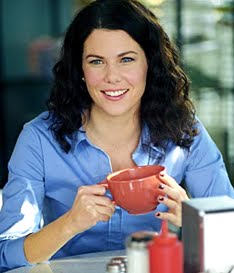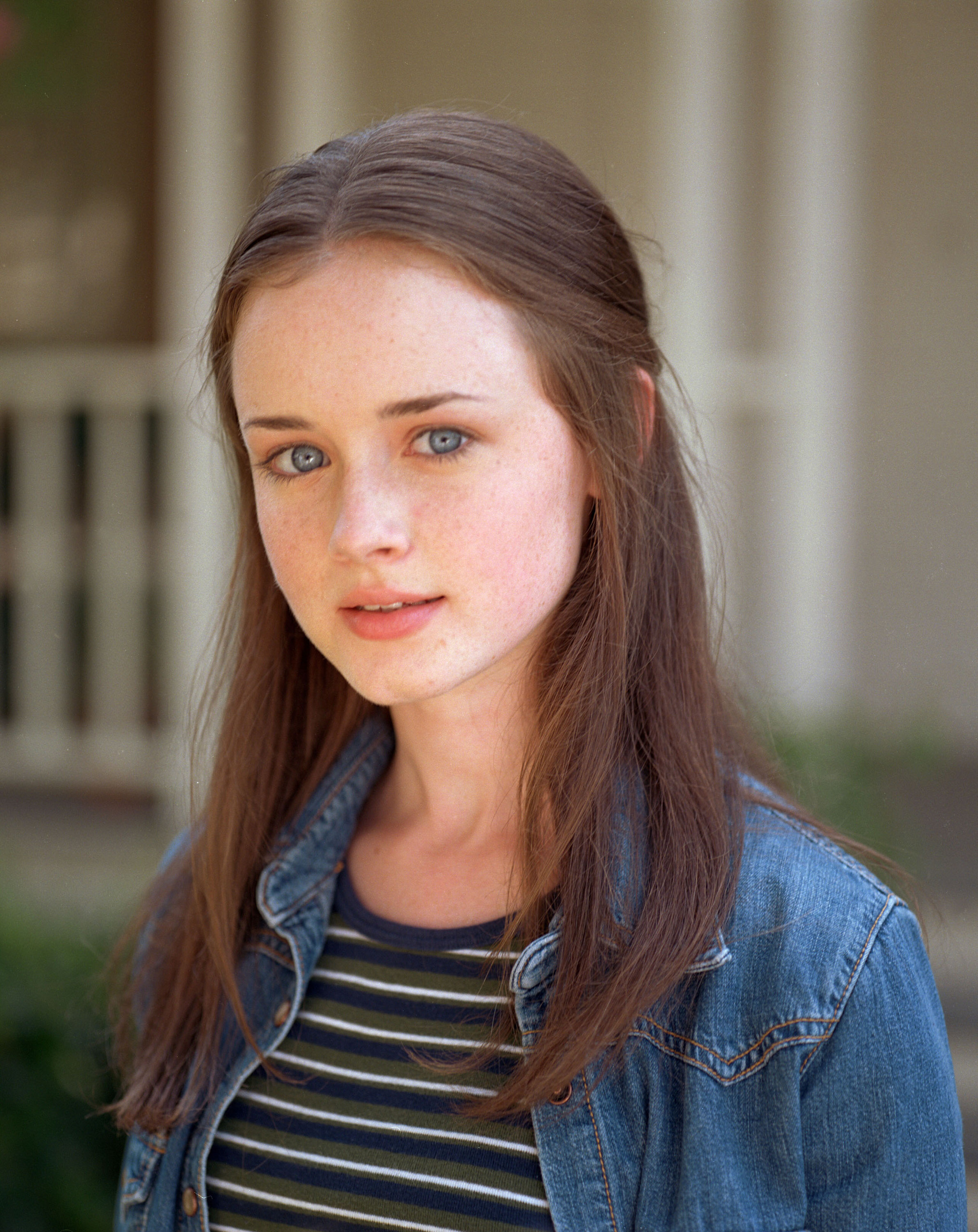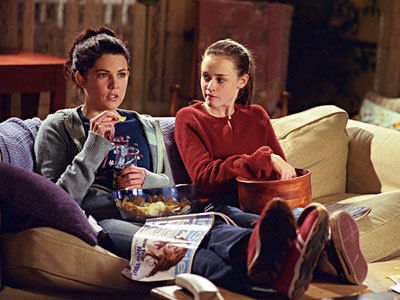———-
Nine Months Forward, Three Centuries Back by Tyler Adams:
Nine Months, contrary to all expectations, is not about pregnancy. It’s about a man coping with a pregnancy. Yes. Here’s a film whose subject absolutely and biologically requires a woman – and it’s still about a man.
However, Nine Months does achieve sex equality of the most dubious sort – it’s insulting to men and women.
In the world of Nine Months, women have already accepted that their value lies primarily in their fecundity and that raising children is the only thing that matters. And now, it’s time for men to learn the same lesson.
Mothers of Anarchy: Power and Control in the Feminine Sphere by Leigh Kolb:
The Mothers of Anarchy, on the surface, have no control. In reality, they have all of the control.
The matriarch “old lady” (the endearing term club members give to their partners) of the California motorcycle club is Gemma (Katey Sagal). She is the Gertrude-inspired character who has married one of the original members of the club, after her husband was killed. Her first husband helped found the Sons of Anarchy motorcycle club after Gemma became pregnant with their son and wanted to settle in Charming, where her parents were from. She may not ride, but her instincts and desires steered the club from its inception. The town’s police chief refers to Gemma as “leaving Charming when she was sixteen and showing up 10 years later with a baby and a biker gang.”
On the surface, it’s so easy to criticize Margaret. But there is something so inherently evil yet desperately loving about Laurie’s pitch-perfect performance of the religion-stricken single mother. You know she wants what she thinks is best for her child, like all great mothers do. But she’s too terrified—or terrifying?—to really consider what she’s saying. She wanted Carrie to be God-fearing, like herself. She wanted her to not suffer the tainted feeling of self-disgust with which she was burdened every day. In essence, she wanted her daughter’s life to be better than her own, by not making the same mistakes she did.
But when Mrs. White saw her daughter developing breasts and getting her period, and even receiving interest to attend the prom, her maternal preference overwhelmed her. She had to intervene before her Carrie ended up shameful, deflowered and ungodly like she had become. It was imperative.
Three Generations of Mothering on The Gilmore Girls by Megan Ryland:
For me, no television mother springs to mind faster than Lorelai Gilmore of the long running show The Gilmore Girls. In fact, what is arguably so special about the show is that it offers a popular mainstream venue to focus on mothering, and especially the challenges of mother/daughter relationships. Of course mothers are a constant feature in the media (how else would mothers know how to behave!?) but teenagers are rarely depicted as having a positive relationship with their mother. Rory and Lorelai have a tight bond that remains the central focus of the show despite relationship drama for both mother and daughter. They also bring in the dual roles of mother and daughter when Lorelai interacts with her own mother, Emily.
Rosemary’s Baby by Erin Fenner:
Rosemary’s Baby, the Roman Polanski 1968 adaptation of the novel with the same name, uses minimal effects. While it is a horror story about the mother of Satan’s child, we only briefly glimpse the arm and eyes of the feature’s supposed monster. And, while the plot against Rosemary is conceived by a coven of witches, we don’t see bubbling potions. That is because Rosemary’s Baby is not a horror story about Satan or witchcraft.
Rosemary’s Baby is a horror story about being a woman.
Rosemary, played by the waifish Mia Farrow, is a young woman excited for her role as wife and soon-to-be mother. But, even in her acceptance and celebration of traditional gender roles she is exploited, robbed of autonomy, discounted as hysterical and ultimately must give up all control of herself and her body.
Sound familiar? That’s because her terrors are real ones with just a dash of supernatural motivations.
The Evolution of Margaret White by Carrie Nelson:
I saw the 1976 version of Carrie for the first time nearly five years ago, and it wasn’t until recently that I realized what doesn’t work for me about Laurie’s performance – it’s entirely one-dimensional. It’s cartoonish, even. It’s hard to be frightened by Laurie’s Margaret when she seems so unlike any mother who could realistically exist. But that isn’t how the character has to be. I thought about this in March, when I saw the MCC Theater’s Off-Broadway revival of the Carrie musical. Now, I did not see the original version of the musical, which opened on Broadway in 1988 and closed after only five performances, making it one of the biggest Broadway flops of all time. I cannot speak to that version, but I can speak to the heavily revised revival, in which Marin Mazzie played an unnervingly sympathetic version of Margaret. Though the story is the same, and Margaret is still deeply disturbed and abusive, there is a greater emphasis on Margaret’s inner struggle and the reality that she truly wants to help her daughter. In the second act, Margaret sings, “When There’s No One,” a moving ballad that reveals her intention to murder her daughter and the despair she feels about that decision. Rather than solely seeing Margaret’s evil and rage, in this version we see her rationalization. We see a fully developed character, a person who truly believes she is making the right decision, which makes the decision even more horrifying. There is nothing cartoonish about Mazzie’s Margaret, which made her far more terrifying than Laurie’s Margaret ever could be.
Sherrybaby by Gabriella Apicella:
What is so extraordinary about “Sherrybaby” is the main character is so completely rounded and real that she bursts free from the predictable constraints imposed by stereotypes. The film follows Sherry Swanson, played by Maggie Gyllenhaal, as she tries to reconnect with her daughter after being released from prison. Yet although this provides the main motivation for virtually everything she does in the film, writer and director Laurie Collyer has brought to the screen a female character who is not just a passionate mother, not just a recovering addict, not just a victim of abuse, not just a sexually confident woman, not just a sweet primary school teacher, but ALL of these things.
Spawning the World: Motherhood in Game of Thrones by Rachel Redfern:
Game of Thrones is the buzzword for this season’s TV community: the backbiting, the plotting, the violence, the sex (which everyone is discussing). What horrific plot twist will the Lannisters think of next, we wonder out loud?
So I won’t really talk about those things, because to my mind, those aspects of the show have been reviewed by dozens of worthy reviewers: The New Yorker, The New York Times, The Mary Sue and Bitch Flicks, just to name a few. (If you’re not really sure of the plot or premise of the movie, you should definitely Wikipedia it, as I’m not really going to talk about that here, considering that so many other reviewers and websites have already provided a synopsis for it.)
One of the aspects that struck me in the show though, is the portrayal of motherhood. Far from being absent or swept to the side, the film’s mothers are a driving force in the plot development and are some of the most multi-dimensional of the series (credit has to be given to the actresses who play them).
There are thee instances of motherhood being portrayed here: Cercei and Lady Arryn’s obsessive, spoiling, “my child is a god” kind of motherhood, Lady Stark’s “good mom” style, and lastly, the Dothraki queen Daenerys Targaryen’s pregnancy where she is worshipped by her people.
Phoebe in Wonderland by Stephanie Rogers:
The caretaker role falls exclusively to Hillary. She’s a stay-at-home mom trying to write a book while also attempting to care for two young daughters. While her struggle to play The Good Mom definitely lends sympathy to her character—I mean, honestly, what the hell is a good mom?—I couldn’t help but despise her selfishness and blatant disregard for Phoebe’s needs. Even though both parents decide to (finally) get Phoebe into therapy, it’s Hillary who refuses to accept the doctor’s diagnosis, even going so far as to remove Phoebe from therapy, deliberately hiding the diagnosis from her husband.
The problem here, and where the movie most succeeds, is that Hillary feels alone as a parent. She believes that her children’s struggles will ultimately reflect poorly on her as The Good Mom, and she even says at one point that she doesn’t want her daughter to be “less than.” Obviously, we live in a society that mandates the over-the-top importance of living up to an unattainable standard of proper mothering (see: any celebrity mother and the scrutiny she faces, with barely a mention of celebrity fathers), and Hillary definitely effectively represents that unattainable standard.
The Great Lie by Erin Blackwell:
There are two scenes in The Great Lie that made an indelible impression on my teenage psyche. One involves crossdressing, the other involves food, and both express the anxiety attached to giving birth and the difficulties modern women have integrating this biological imperative into an otherwise blithely artificial lifestyle. But mostly, these two scenes depict powerful moments of emotional intimacy between women in which conventional gender roles go out the window.
Laurie Petrie of The Dick Van Dyke Show by Caitlin Moran:
Laura and Rob Petrie had one child together, a son named Richie. Because Richie is in elementary school for the whole of the show, Laura’s role as a mother focuses on the challenges of raising a small child. She worries that he might be sick when he refuses a cupcake, and helps Rob explain why Richie’s middle name is Rosebud. (It’s an acronym for the names that their parents and grandparents suggested for the baby. Unsurprisingly, that was Rob’s idea.) In the episode “Girls Will Be Boys,” Richie comes home from school three days in a row with bruises on his face, and admits that a girl has been beating him up. After Rob’s visit to the suspected lady bully’s father turns up empty, Laura goes to the child’s house to get to the bottom of the strange beatings. After the girl’s mother insults and dismisses her, Laura refuses to leave until she’s said her piece. “You may not be the rudest person I’ve ever met,” she declares with her trademark quiver, “but you are certainly in the top two.” Door slam, and our girl storms off with the moral high ground and not a hair out of place in her perfect coif.
Absent Mothers in Urban Fantasy by Paul and Renee:
Just because Urban Fantasy is largely produced by women and consumed by women does not mean that it is free of sexism and misogyny. When it comes to motherhood, a role that most women will one day assume, it is hardly surprising that within the genre most examples are highly problematic — when they appear at all.
The lack of representation of motherhood is so extreme that the viewer is forced to ask is, “where are the mothers?”. It seems like such an odd question, because you’d expect most characters, like most people, to have a mother lurking around somewhere; especially since most of the heroines in these stories are young women or even teenagers. Search as we might, the mothers are conspicuous by their absence.
Being a Good Mother in Gilmore Girls by Friederike Wunschik:
Lorelai Gilmore is certainly depicted as a non-conventional mother. She has been described as a “disgraced Connecticut Brahmin teen heiress who flees prep school to keep and raise her now teen-aged daughter while estranged from her own parents” (Jennifer Crusie, Coffee at Luke’s, p. 174). But she is not the only mother in the series. Gilmore Girls spends a surprisingly large amount of time focusing on mother-characters, some of which are shown more often and more in-depth than others.
Hey, Let’s Do Some Mommy Issues! (Babies Not Required) by Glosswitch:
The thing is, I wouldn’t mind if characters like Rachel and Catherine were just like all the other characters – ridiculously gorgeous and ace at their jobs, yet somehow flawed and kooky at the same time – while also being mommies, albeit ones whose lives aren’t that much impinged on by having a child. I wouldn’t mind that. It’s just that Rachel and Catherine seem to have MOMMY tattooed in big letters across their botoxed foreheads. You can almost hear the sound of scriptwriters patting themselves on the back. “Hey guys, relax! We’ve done the “mommy issues” bit! Now let’s send everyone off to Central Perk.” This creates an environment in which it no longer seems legitimate to assert that motherhood still doesn’t really exist as a theme in our TV programmes. But by and large it doesn’t. You wouldn’t have to do much. You don’t literally have to show shitty diapers or a woman crying her eyes out at 3am with engorged breasts and a howling newborn. It’s just the little things. Perhaps you have women who aren’t able to go to the bar with colleagues at the drop of a hat. Women who don’t always have childcare issues magically resolved by a grumpy ex who’s half new man, half self-pitying passive aggressive bully. Women who work part-time. Women who are, most of the time, in the company of children, not for one “doing the issues” childcare episode, but all the time. You can still have humor and drama in that. Let’s face it, children can be total lunatics; there’s loads of humor and drama in that.
Julia Roberts in Steel Magnolias, Step Mom, and Erin Brockovich by Allison Heard:
Steel Magnolias shows the undying love of mothers and daughters through disagreements, tragedy and happiness. Shelby exemplifies the young woman desiring to become a mother despite unruly and unpredictable circumstances. Her choice to bear children despite her physical limitations shows that all she wanted was motherhood, despite the cost. M’Lynn exemplifies the experienced mother who only wants to protect her daughter from harm. Both Shelby and M’Lynn make the ultimate sacrifice for motherhood, that being a kidney and a life.
According to Horrornews.net: “She is absolutely riveting and roles like this, especially for women, are almost never found in American cinema.”
This quote ultimately summarizes my experience with MOTHER – a film about a mother willing to do whatever it takes to save her child. In many American films, mothers are often portrayed as deranged (such as the biopic Mommy Dearest) or some kind of superhero (based entirely on tropes) mom who does everything for everyone else but nothing for herself (such as I Don’t Know How She Does It, starring Sarah Jessica Parker).
Is Terminator‘s Sarah Connor an Allegory for Single Mothers? by Megan Kearns:
As kickass as she is, Sarah possesses no other identity beyond motherhood. She exists solely to protect her John from assassination or humanity will be wiped out. Every decision, every choice she makes, is to protect her son. In Sarah Connor Chronicles, Cameron tells Sarah that “Without John, your life has no purpose.” Sarah tells her ex-fiancé that she’s not trying to change her fate but change John’s. Even before she becomes a mother in Terminator, her identity is tied to her uterus and her capacity for motherhood.
Now, I realize she’s saving the world, trying to keep her son alive and stop a cyborg onslaught. But the underlying theme — motherhood must consume women — is troublesome. Mothers don’t have to squelch their desires and sacrifice their identity and entire lives in order to be a “good” mother.
The Authentic Portrayal of Mother-Daughter Relationships in Future Weather by Stephanie Rogers:
I recently saw the film Future Weather at the Tribeca Film Festival and was blown away by the honest portrayal of motherhood onscreen. The film captures the ups and downs characteristic of mother-daughter relationships and does so without simplifying the women or relegating them to either/or binaries; there is no exclusively Good Mom or Bad Mom in this film. Not only is it nearly unheard of in films today to watch women interact with one another in ways that don’t involve men, but in typical feature films showcasing mother-daughter relationships, audiences are often subjected to a litany of unrealistic absolutes: Good Moms always love and nurture their daughters, sacrificing their entire adult existences and maintaining some virgin-esque purity while doing so; yet Bad Moms ruin their daughters’ lives through manipulation, neglect, or—conversely—smothering and over-protection, to the point that the audience labels these mothers nothing more than villains—usually mentally unstable villains—with no redeeming qualities whatsoever.
But Future Weather avoids these clichés. The women in this film lead hard, complex lives. We know these women. We live with these women. Their interactions remind of us our own multifaceted mother-daughter relationships. And, fortunately—while they’re sometimes messy and often difficult to watch—the women in Future Weather aren’t treated as tropes to merely move a plot forward (no dead ladies/moms for dudes to avenge the deaths of!), and the filmmakers spare the audience from two hours of that cringe-worthy, all-too-familiar “lone woman among a group of complex, likeably awful men” thing.





